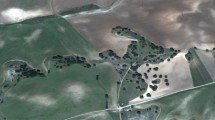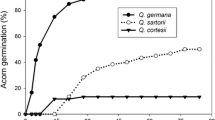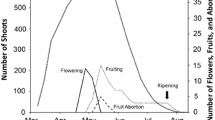Summary
Quercus oleoides Cham. and Schlecht is an unusual tree in several respects: it is an oak found in neotropical lowland forests, its distribution is not continuous but ratherdivided into many patches of various sizes, and it is a dominant in all the forests in which it occurs, attaining densities far higher than most species of tropical trees. This density pattern is related to the vulnerability of Q. oleoides acorns to predation by mammals. Observations of agoutis, deer, peccaries, squirrels, pocket mice and other seed consumers in Santa Rosa National Park, Costa Rica, showed that these mammals act only as predators, not dispersers, of Q. oleoides acorns. Experiments which involved placing acorns in deciduous forest where Q. oleoides does not occur, demonstrated that, due to high predation rates, the number of acorns produced by an isolated tree is far too low for adults to replace themselves.
In oak forest, on the other hand, where the combined acorn crops of many oaks satiate the seed predators, acorn survivorship until germination is high enough to maintain the population. Furthermore, acorn survivorship in oak forest areas is inversely proportional to the apparent mammal density in those areas. Thus the pattern of forest dominance and patchy distribution is related to positively density-dependent acorn survivorship: where Q. oleoides is the forest dominant, it will survive, but if its density falls to the level typical of tropical trees, it will go locally extinct.
Similar content being viewed by others
References
Bartlett HH (1935) A method of procedure for field work in tropical American phytogeography based on a botanical reconnaissance in parts of British Honduras and the Peten forest of Guatemala. Carnegie Inst Wash Publ 461:1–25
Boucher DH (1979) Seed predation and dispersal by mammals in a tropical dry forest. Ph. D. Thesis, University of Michigan. pp 211
Burger W (1977) Fagaceae. Pp 59–82 in Burger, William, ed., Flora Costaricensis, Families 42–53. Fieldiana: Botany 40.
Fleming TH (1971) Population ecology of three species of neotropical rodents. Misc Publ Mus of Zool Univ Mich 143
Fleming TH (1974) The population ecology of two species of Costa Rican rodents. Ecology 55:493–510
Gomez-Pompa A (1965) La vegetacion de Mexico. Bol Soc Bot Mex 29:76–120
Gomez-Pompa A (1966) Estudios Botanicos en la Region de Misantla, Veracruz, Mexico, DF: Instituto Mexicano de Recursos Naturales Renovables
Harris WB Jr (1937) Revision of Sciurus variegatoides, a species of Central American squirrel. Misc Publ Mus Zool Univ Mich 38
Hartshorn GS, Hatheway WH (1972) Composition and dynamics of forest ecosystems in Costa Rica. Mimeographed. Seattle: University of Washington College of Forest Resources.
Holdridge LR, Grenke WC, Hatheway WH, Liang T, Tosi JA, Jr (1971) Forest Environments in Tropical Life Zones: A Pilot Study. Oxford: Pergamon
Hubbell SP (1979) Tree dispersion, abundance and diversity in a tropical dry forest. Science 203:1299–1309
Janzen DH (1971) Seed predation by animals. Ann Rev Ecol Syst 2:465–492
Janzen DH (1974) Tropical blackwater rivers, animals, and mast fruiting by the Dipterocarpaceae. Biotropica 6:69–103
Janzen DH (1978) Description of a Pterocarpus officinale (Leguminosae) monoculture in corcovado National Park, Costa Rica. Brenesia 14–15:305–309
Martinez M (1974) The oaks of Mexico. XV. An Inst Biol Univ Nac Aut Mex 45:21–56
Martinez y Ojeda E, Gonzalez F (1977) Vegetacion del sudeste de Tamaulipas, Mexico. Biotica 2(2):1–45
Miranda F (1952) La Vegetacion de Chiapas. Tuxtla Gutierrez, Mexico: Ediciones Gobierno de Chiapas
Miranda F, Hernandez E (1963) Los tipos de vegatacion de Mexico y su clasificacion. Bol Soc Bot Mex 28:29–179
Montoya J (1966) Notas fitogeograficas sobre el Quercus oleoides Cham. y Schlecht. Turrialba 16:57–66
Muller CH (1961) The live oaks of the series Virentes. Amer Midl Nat 65:17–39
Pennington TD, Sarukhan J (1968) Arboles Tropicales de Mexico. Rome: FAO
Puig H (1972) Estudio de la sabana de Huimanguillo, Tabasco. In Mem Primer Cong. Latinoamericano y Quinto Mexicano Bot 389–411
Puig H (1976) Vegetation de la Huasteca, Mexique. Mexico, DF: Mission Archeologique et Ethnologique Française au Mexique
Richards PW (1964) The Tropical Rain Forest. Cambridge: Cambridge University Press
Sarukhan J (1968) Analisis sinecologico de las selvas de Teriminalia amazonia en la planicie costera del Golfo de Mexico. Tesis de MS. Chapingo, Mexico: Colegio de Posgraduados, Escuela Nacional de Agricultura
Servicio de Parques Nacionales (1977) Los Parques Nacionales de Costa Rica. San Jose: Servicio de Parques Nacionales
Shaw MW (1968) Factors affecting the natural regeneration of sessile oak (Quercus petraea) in North Wales. II. Acorn losses and germination under field conditions. J Ecol 56:647–660
Sork VL, Boucher DH (1977) Dispersal of sweet pignut hickory in a year of low fruit production, and the effect of predation by a Curculionid beetle. Oecologia (Berl) 28:289–299
Sousa M (1963) La vegetacion secundaria en la region de Tuxtepec, Oaxaca. Tesis Profesional (Biologo). Mexico, DF: Escuela de Biologia, Facultad de Ciencias, UNAM
Standley PC, Steyermark JA (1952) Fagaceae. In Flora of Guatemala, Paul C Standley, and Julian A Steyermark (eds), Fieldiana: Botany 24, Part III
Vandermeer JH, Boucher DH (1978) Varieties of mutualistic interaction in population models. J Theor Biol 74:549–558
Von Borries OH (1967) Estudio de las caracteristicas ecologicas de la asociacion de encino (Quercus oleoides Schlecht. y Cham.) en Guanacaste, Costa Rica. MS thesis, IICA, Turrialba, Costa Rica
Author information
Authors and Affiliations
Rights and permissions
About this article
Cite this article
Boucher, D.H. Seed predation by mammals and forest dominance by Quercus oleoides, a tropical lowland oak. Oecologia 49, 409–414 (1981). https://doi.org/10.1007/BF00347608
Received:
Issue Date:
DOI: https://doi.org/10.1007/BF00347608




